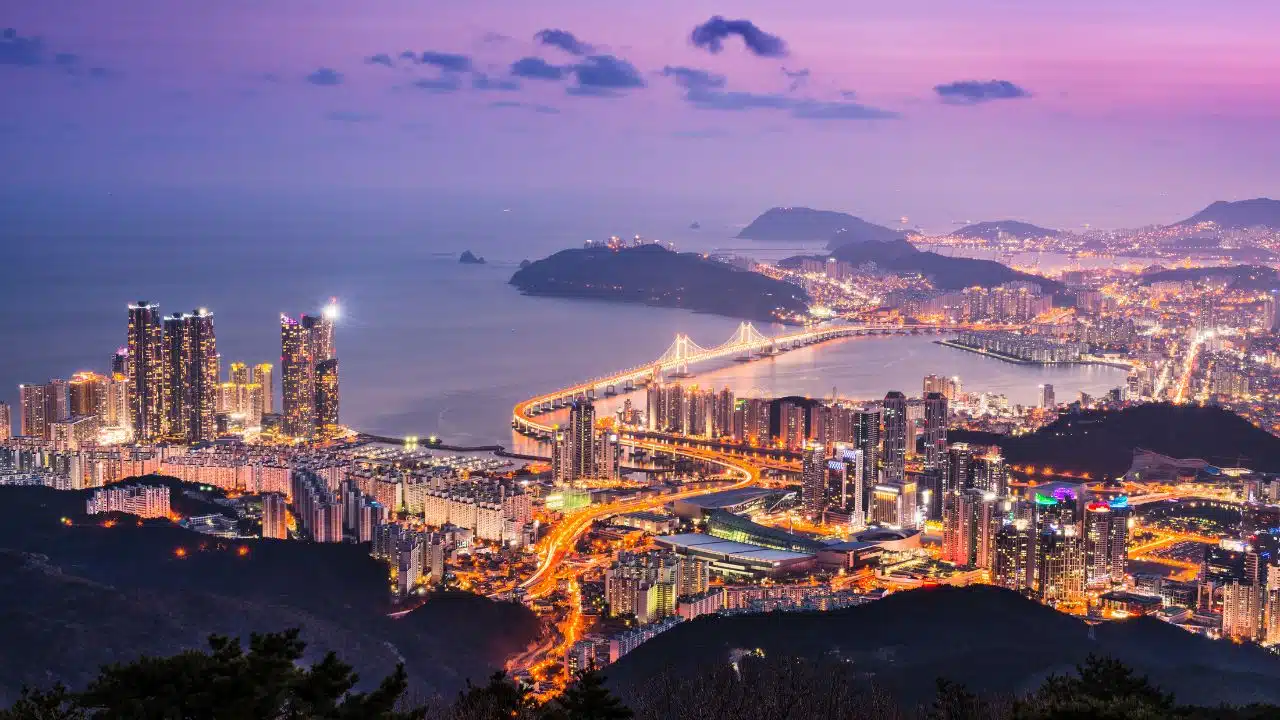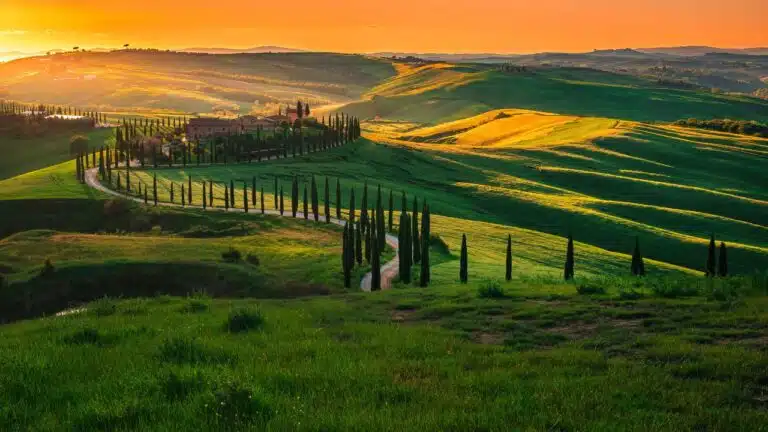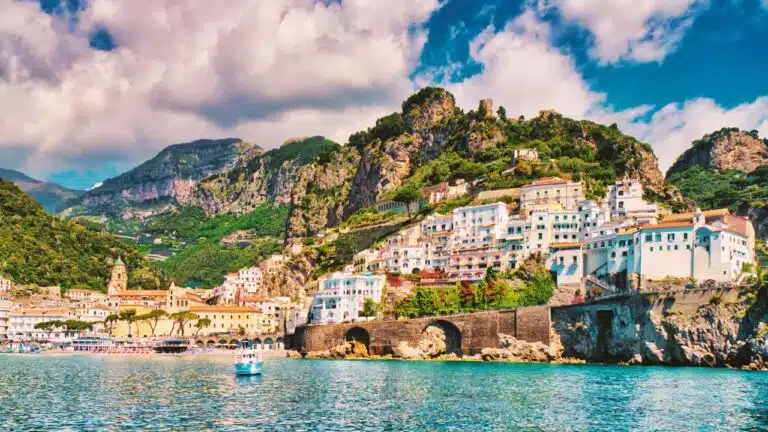A perfect blend of innovation and tradition, South Korea brims with modern comforts, lively history, and magical moments scattered throughout the year. So, if you’re looking for a bad time to visit, you’re looking in the wrong place. Marked by year-round festivals and explosions of color, the Land of Morning Calm is a beauty to behold in every season. But with so much to see and do, comes the inevitable question of when exactly is the best time to visit South Korea.
While you can visit anytime, your experience can vary widely depending on when you go. So, here’s your South Korea weather guide for choosing the perfect season to visit, along with tips for some of the best activities to do in all four seasons.
Table of Contents
- South Korea Weather Overview?
- What Is the Best Time of Year to Visit South Korea?
- Spring, Summer, Fall, or Winter — Next Vacay Can Save You BIG on Flying to South Korea
South Korea Weather Overview
South Korean weather is both familiar and predictable. While other countries in Asia have vastly different seasons, South Korea experiences four distinct seasons throughout the country, with only slight variations in temperature between the mountains, the cities, and the coasts.
Throughout the year, the average temperature ranges from 15°F to 85°F. Winter pairs clear skies with freezing temperatures but little rain, while hot summers promise plenty of humidity and rainy days amid a mild monsoon season. This leaves spring and fall with generally pleasant weather that includes mild temperatures and bright bursts of color.
What Is the Best Time of Year to Visit South Korea?
The best time to visit South Korea is undoubtedly springtime. Bright cherry blossoms paint South Korea in gorgeous shades of pink and boisterous festivals bring the country to life. A close runner-up, autumn never fails to amaze either. Colorful leaves and crisp autumn air make the country ripe for exploration.
That’s not to say that summer and winter are without their charms. Though the summer weather can be a mixed bag—it is monsoon season after all—it’s still a fantastic time to visit South Korea. Big festivals dominate the summer, and visitors can escape the city heat by fleeing to the mountains or the coast.
However, winter will mean stacking layers rather than shedding them. Cold and snowy, but thankfully dry, winter sees frequent snowfall, bringing fun winter sports and enchanting blankets of snow, especially in the northern regions of South Korea.
Spring in South Korea (April – June)
Spring reigns as the best time to visit South Korea. Cherry blossoms, azaleas, and other spring flowers blanket every inch of the country, from busy corners to the idyllic countryside, playing a small but definitive role in South Korea’s top destination status.
The daily highs range from breezy to mild. April starts with an average temperature of 50°F, and swathes of flowering buds make it one of the best months to visit South Korea. By May, spring is in full swing, with temperatures ranging from a cool 48°F to a pleasant 62°F, ushering in lush greenery and full blooms. By June, you can toss the sweaters and say hello to T-shirt weather as it warms to an agreeable 70°F.
Packing extra layers for the evenings is the smart approach to spring. However, while the mountains remain fairly cool and the cities can dip below freezing in early spring, the country’s southern coast is already experiencing warmer temperatures in April.
See the Cherry Blossoms
Cherry blossoms mark the end of winter and the start of spring, and many consider it to be the best time to visit South Korea when these gorgeous flowers bloom. Though cherry blossoms begin blooming in late March on Jeju Island, it’s worth waiting for the cherry blossom festivals held in April on the mainland.
Jinhae Gunhangje Cherry Blossom Festival is the biggest spring festival in Korea. Ten days long, the celebration features light shows at night and the famous “Romance Bridge,” named after a popular K-drama shot there.
Yeouido Cherry Blossom Festival has the Han River as its backdrop. Flowers dot the path, including the famous Jeju cherry trees, and visitors are bathed in petals and scents with every breeze.
Seokchon Lake Cherry Blossom Festival takes place on a public lake turned spring wonderland. Under blooming cherry trees, the lake becomes a soft-hued fairytale with breathtaking scenery.
The mild temperatures and blooming cherry blossoms play a large part in crowning spring as the best time to visit South Korea.
Take in the Taean Tulip Festival
Cherry blossoms aren’t the only flowers in bloom. Spring sees the largest tulip festival in South Korea take place in Taean. A grand display of color awaits, with tulips arranged in artful displays centered around an annual theme. The vibrant colors make for stunning photo ops.
There’s no denying spring is in the air when taking in the Taean Tulip Festival.
Explore Jeju Island
Jeju Island is one of the most beautiful parts of South Korea. In the spring, this becomes indisputable—the island bursts with color, from pink cherry blossoms to bright yellow canola fields. Visitors hoping to enjoy the beaches or trek the mountains will appreciate the warm temperatures without the humid weather.
The beauty of Jeju Island’s majestic peaks, cascading waterfalls, and sweeping coastlines explain why it’s a top honeymoon destination for Koreans.
Experience the Jindo Miracle Sea Road Festival
Spring isn’t just the best time to visit South Korea for this mystical phenomenon. It’s the only time.
During late April/early May, the sea parts and the Jindo Miracle Sea Road appears for one magical hour. The fleeting path draws hundreds of thousands of people to the southern tip of South Korea to experience this incredible event firsthand.
Summer in South Korea (July – August)
Summer is widely considered to be the worst time to visit South Korea. It starts with jangma, or monsoon season, which brings heavy rain and warm days starting in late June or early July. Thankfully, you don’t have to worry about extreme monsoons here, but you can expect some torrential rains. More than half of the country’s annual rainfall comes from early July to late August, with the wettest month being the former. So, steer clear of July if you want to avoid most of the rain.
Despite the bad rap, there’s truly no bad time to visit South Korea, and the summer months undoubtedly have their charms. With highs hitting 80°F in July and 85°F in August, summer is the perfect time to escape into the mountains and coastal towns. Fresh breezes waft from the coast in places like Jeju Island and Busan, while lofty mountains and scenic valleys provide shade to take the edge off the heat.
And the unique festivals and events during the summer make it well worth the heat.
Check Out Buyeo Seodong Lotus Festival
Spring doesn’t claim all the vibrant blossoms. July is the best time to visit South Korea for the lovely lotus flower, and in Buyeo County, they shine by the millions. The Buyeo Seodong Lotus Festival celebrates the special lotus flower with performances, crafts, competitions, and even lotus tea ceremonies, with nights capped off by enchanting light shows and parades.
Snorkel at Jangho Beach
Escape the sweltering heat of Seoul by heading to the east coast, to a town in Samcheok called the Naples of Korea. Jangho Beach is famed for its breathtaking coastal views and stunning underwater scenery. The water is clean and so clear you likely won’t even need snorkeling gear to explore its depths. But chances are, you’ll find yourself tempted below the surface anyway.
Spend the Day at Lotte World
South Korea doesn’t have a Disneyland park, but it does have Lotte World. The biggest indoor theme park in Asia, Lotte World is a faithful escape from the summer heat in Seoul. Roller coasters, a giant ice rink, and even a folk museum bring hours of endless amusement sequestered away from the elements. And on pleasant summer days, the outdoor park of Magic Island awaits.
A second park opening in 2022 means visitors to Busan can also delight in the singular magic of Lotte World.
Visit the Damyang Bamboo Forest
Spring and autumn are when most forests in South Korea get their time to shine, but the Damyang Bamboo Forest is different. Lush and green year-round, summer is the best time to visit this beloved spot in South Korea and walk the winding forest paths shaded by towering bamboo stalks. Between the forest, cafes, and cultural village, you’ll find plenty of space to roam, snap pics, and enjoy the summer breezes.
Get Messy at Boryeong Mud Festival
Summer is the only time to experience this made-for-a-bucket-list event. It’s not every day that you get to hurl mud at other people and dive headfirst into piles of it, but the Boryeong mud fest is an event unlike any other. Thanks to the nutrient-rich mud flats of Daecheon Beach, Boryeong’s mud became a big ingredient in cosmetic items, eventually leading to this mud-promoting celebration. For two weeks, festival-goers can revel in all things mud with fun games and obstacle courses. And don’t think you can come away unscathed; mud-dodgers get thrown in prison and subsequently pelted with mud.
Fall in South Korea (September – November)
Not to be outdone by spring, fall promises its own spectacle of lights, colors, and festivals. If not the prime time for a visit to South Korea, the autumn months still offer an enticing display for your vacation.
Cooler temperatures offer a welcome respite from the summer heat. September to November see sunny days with average highs between 55°F and 68°F, perfect weather to don your cozy knit sweaters. Blue skies and crisp air crown autumn as the best time to visit national parks and ancient temples in South Korea. However, visitors may want to avoid late September/early October, as this is when one of the year’s biggest holidays, Chuseok (Harvest Moon Festival), takes place.
Stroll Ginkgo Tree Road
Ginkgo Tree Road is one of the best places to take in the colorful splendor of South Korea’s autumn coat. Located in Asan, the Gingko Tree Road is the quintessential picture of fall. Towering trees border the path, and bright yellow leaves turn it into a real-life yellow brick road sans the brick. With the Han River off to the side, it’s the perfect place to stroll, bike, or plan a picnic under the bright fall canopy.
Experience the Culture of the Korean Folk Village
The Korean Folk Village is a living museum that takes visitors back in time to the Joseon Dynasty. Over 250 traditional homes and buildings give visitors a glimpse of traditional life and culture in 19th-century Korea. Actors wear traditional clothing called hanbok and perform daily tasks, while others put on shows of music, acrobatics, and even wedding ceremonies.
Don a hanbok yourself, glide through the air on a wooden swing, and dive deep into the history and culture that make South Korea so distinct.
Hike the Trails of Seoraksan National Park
The mountain trails of Seoraksan National Park unveil fall in all its splendor, making it abundantly clear why this is one of the best times to visit South Korea. Trees in stunning shades of yellow, orange, and red create a warm rainbow of color.
One of the first designated national parks in South Korea, Seoraksan surges with breathtaking peaks, gorgeous waterfalls, and serene temples. Endless natural beauty makes Seoraksan a must-see destination. Though it’s considered a year-round spot, the fiery hues of autumn make September to November the best time to visit this national treasure of South Korea.
Visit the Bulguksa Temple
History abounds at Bulguksa Temple, where the rolling hills stand as the resting place of royalty. Located in the beautiful coastal city of Gyeongju, Bulguksa has been designated a UNESCO World Heritage site.
Highlighting the golden age of Buddhist art, the temple contains six National treasures of South Korea, including the two stone pagodas, the Amitabha Buddha statue, and the Blue Cloud and White Cloud Bridges of Bulguksa Temple. Autumn is the perfect time to soak in the beauty and history of such a significant place.
Attend the Seoul Lantern Festival
One of the best times to visit Seoul, South Korea has to be in autumn during the Seoul Lantern Festival. Not only is the weather in the city generally pleasant in November, but for two weeks, the nights are lit ablaze with the glow of paper lanterns and LED sculptures in a captivating display of light and color.
Just under a mile long, the lanterns stretch from Cheonggye Plaza to the Supyo Bridge along the Cheonggyecheon Stream. There’s also a section to buy and launch your own paper lantern boat in hopes your wishes will come true.
Winter in South Korea (December – March)
Winter in South Korea is long, which is good news for fans of winter sports and ski resorts. Despite the freezing temperatures, the long winter isn’t without its charms, and outdoor activities abound to keep visitors entertained. For those who consider winter the best time to travel, you can’t go wrong with a visit to South Korea as it dons its winter coat.
Relatively dry, winter sees very little rain and quite a lot of snow in the country’s mountainous regions. As a result, the average temperature in the mountains and interiors can get up to 37°F during the day. However, this drops significantly to hit an average of 19°F overnight.
In contrast, the southern coast sees mild temperatures, with a high of 45°F and a low of 25°F.
Go Sledding at Everland
Everland is the largest theme park in Korea and offers a magical wintertime experience. From moonlight parades to a harrowing wooden roller coaster ride, Everland is full of fun, but the sledding experience is a winter highlight that’ll make you feel like a kid again.
Try to plan your visit in November/December, when you can enjoy the Winter Wonderland festival, which features a jaw-dropping amount of Christmas lights.
Ice Skate Outdoors in Seoul
If you’re visiting Seoul in the winter, add ice skating to your list of must-do activities. You’ll find ice rinks dotting the city, and while Seoul has its share of indoor ones, head outside for the fresh air and views.
Serious daytime fun awaits at Olympic Park, with a full range of facilities and the park to fill your day. Or, wait till nightfall for a romantic date-night skating at the Grand Hyatt Seoul Ice Rink with technicolor lights and picturesque views over Seoul.
Ski at Bears Town Resort
The best way to enjoy a Korean winter isn’t by escaping the cold but by running toward it. Conveniently located an hour outside Seoul and far less crowded than more popular ski resorts, Bears Town is no slouch for winter sports. The resort’s powdery slopes range from beginner to expert, and you can rent your gear of choice from the authentic wood cabins serving as stalls.
Bears Town is the perfect place to spend a day dusting the slopes, whether you’re a budding first-timer or a seasoned hotshot.
Watch the Seogwipo Penguin Festival
The Penguin Swimming Festival in Seogwipo doesn’t feature actual penguins but scantily-clad humans taking a dip in the winter sea around Jeju Island. Festival-goers gather on New Year’s Day at noon to run headlong into the freezing waters.
While many only spectate, those brave enough to withstand the chill can wash away last year’s troubles and look forward to a healthy and happy New Year—and hopefully a much warmer one too!
Spring, Summer, Fall, or Winter — Next Vacay Can Save You BIG on Flights to South Korea
South Korea weather doesn’t have to define your trip. With something magical to do in every season, there’s no bad time to visit. And you can get a head start on enjoying any season with incredible savings on the perfect flight by signing up for Next Vacay.
Next Vacay monitors your airports and keeps you up-to-date on all the latest deals. So, when a deal pops up to the heart and soul of South Korea in Seoul, you can book it in no time. With deals delivered straight to your inbox, there’s no delay and no jumping through hoops.
You don’t have to worry about the seasons in South Korea. And with Next Vacay, you don’t have to worry about the flights, either. So fly with peace of mind. Fly with Next Vacay.



